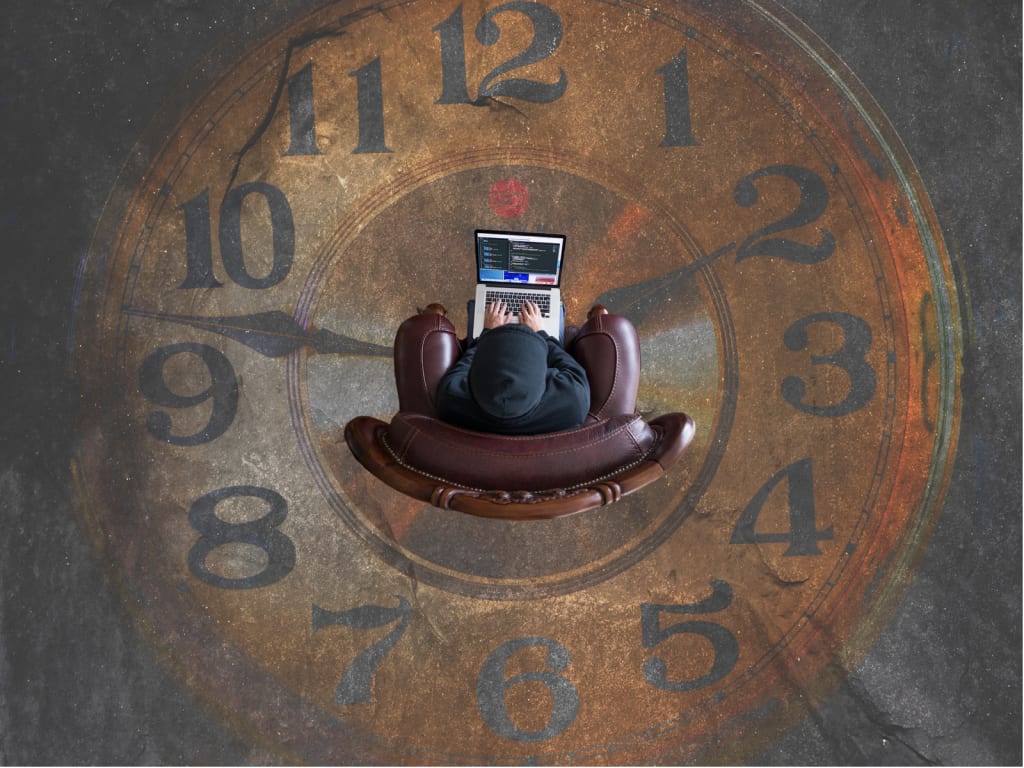Time Management For Creatives
It’s not just about time. It’s about focus, energy — and taking breaks to recover and replenish

It’s a slippery thing, time.
We all get the same amount, yet none of us feel we have enough of it. And what we have seems to slip through our hands.
It’s the issue that my coaching clients bring to me most often. They call it poor time management, lack of time/space/discipline/willpower. Or they call it procrastination. But what it usually comes down to is this: they’re not getting on with the work they really want to do.
They’re often trying to do too much at once, or doing an awful lot that they are not counting as work at all. Or they’re constantly busy, but not making time for the things that are most important to them.
Often these are the big projects, the personal work, the explorations you want to try. It’s work without firm deadlines, waiting clients. Or even a definite financial reward or critical acclaim once you finish. So it’s hard to motivate yourself to get on with them.
Sound familiar? If so, here are nine things that can help.
1. Time is limited. But so is energy, and focus.
You need to manage all three, not just your time. Very few of us can manage more than four hours of totally focussed creative work in a day. Many of us even need to divide that time into shorter sprints, with breaks to recover our energy and attention.
Of course there are magical days when you get into flow, hours fly by like minutes and you’re reluctant to stop to eat or sleep, let alone rest. But those days are rare, and never come when we most need them.
We need regular breaks in our working day, to refocus and to replenish our energy.
Look at the routines of prolific, consistent creators and they’ll often consist of a regular block of time they dedicate to their creative work before attending to other things; or shorter bursts of work followed by recovery time (a walk, a work-out, coffee, time to read or relax).
Most of those people also talk about a magical effect when they finish work with an unresolved problem, and then the next day return somehow knowing the answer. Take more breaks, and your subconscious mind will continue working on it, even if you are not. Research has shown that plenty of sleep, frequent breaks and exercise — especially walking — helps here.
Need convincing? Read Matthew Walker’s book Why We Sleep: The New Science of Sleep and Dreams. It’s full of interesting research and evidence on the power of sleep, and how it enhances creativity. And Alex Soojung-Kim Pang’s entertaining book Rest: Why You Get More Done When You Work Less gives strong arguments for resting more — and for the power of walking.
2. Pay yourself first: make the time you need.
We often wait for a long stretch of uninterrupted time to magically open up, so that we can finally write that book, start that major art project, explore a new direction.
We defer this self-directed work until we’ve cleared the decks, tidied the house, got rid of some commercial jobs that have come in. Or until the children are older, our business is more established or some other milestone has been passed. But of course then there will be new tasks, commitments, and time-vampires greedily waiting to suck up all that ‘spare’ time.
The truth is, you’ll only get the time you want if you take it. And put it on your schedule like any other deadline or appointment.
Ring-fence time for the project you most want to do. And then protect that time fiercely. Act as if it’s an interview with a Hollywood A-lister, a crucial business meeting, a plane you have to catch or a dental appointment.
If you absolutely have to postpone because an irresistible money job comes up or some other emergency, move it to the nearest available space and only move it again if someone’s life depends on it. (Because your creative life does depend on it.)
This isn’t easy, but it’s worthwhile.
It can be difficult, in the stresses of deadlines and day-to-day life to find time. But be ruthless. Maybe it means leaving the house a mess, ignoring phone calls, arranging a play date for your kids, turning down a social engagement. That’s OK.
Maybe you’ll find you only have small pockets of time available, and that’s OK too. Just accept that progress will be slow, and stop beating yourself up about that. If your children are small, a loved one is ill, you’re working full-time, it may be that you can only manage an hour or two a week. But if show up for that time, week after week, your project will move forward.
I know a successful novelist who had a demanding full-time job but wrote her first three books in coffee shops, working for two hours every Saturday and Sunday morning, while her partner looked after the kids. It wasn’t ideal, but it paved the way for her to eventually quit that job to write full-time.
I write well in the mornings, so that’s what I do. Every day, from 8am-9am. Before breakfast, before I even get dressed sometimes. And definitely before giving my time to anything or anyone else. Even if I don’t get back to the page later, knowing I’ve done that hour leaves me at peace for the rest of the day.
Only you can do this: no one will clear the space for you. But it will make the difference between moving forward, and feeling like you’re stuck on an endlessly revolving hamster wheel, running but getting nowhere.

3. Choose one thing
As creatives, we tend to have a lot of ideas. and they’re all exciting. We go off on tangents. We get distracted by the latest new and shiny object. Or we’re juggling several projects at once, and never bringing any of them to completion. Especially when they’re competing with the day to day demands of work and life, friends and family.
Painful though it is, we need to choose one big creative project at a time, and give it our full focus until it’s finished. Then we can choose another.
You’ll get more done that way. You’ll have the satisfaction — and momentum — of completing.
4. Love vs Money
We all need to earn money somehow, whether that's in a day job or more commercial work. But we also have creative projects that are more speculative, that might not immediately increase our bank balance. We need those projects, to grow and learn. To have fun. And to express your unique talents and voice.
Obviously, at some point we hope to reach that sweet spot where we’re paid well to make the work we love. But in the meantime, we need to make space for both. It can help to decide which kind of work you’re doing, and when. Money work you do to the best of your ability in the time available. But you always make room for the love projects, too. That balance is crucial.
5. Get clear on how long tasks really take.
Tracking your time is tedious, but it’s also eye-opening. Try keeping a record of what you’ve been doing, in 30-minute increments, for a week or even a month.
Be honest. This is to help you understand where your time actually goes. Record the time you spend procrastinating (and how), staring into space, scrolling on social media. This is telling you when you’ve lost focus, when taking a break might be more helpful than pushing on through. Also watch out for those points in the day when you’re so weary you lose the ability to decide what’s important, and start doing busy work, just to feel productive.
It will help you become more aware of the tasks you dread doing, that you and put off for days. But which only take a few minutes to actually do. And the tasks you tell yourself should only take an hour — but which really take half a day.
6. Look for energy hangovers.
Some tasks are more demanding than others, and they leave you with energy hangovers. In a busy workplace, there tend to be natural breaks where you can work these off. Walking back to your office after a long meeting, for instance. Or having a chat with a colleague while you make a drink. And of course the commute to and from work is a huge signal to our busy minds that we’re moving from one headspace to another.
But if we work at home or alone in a studio or workshop, we still need to make space for recovery. If we don’t, we’ll find a way of doing it anyway — and it won’t be healthy.
After interviews, meetings or long coaching conversations, for instance, I realised I tend to pointlessly scroll on social media, start long replies to emails I’d usually ignore, and engage in all kinds of other time-wasting activities.
It took a while for me to realise that after such periods of intense concentration and social interaction, I need some space before moving to the next thing on my list. Now I go straight out for a walk to clear my head, or I do a short workout. When I come back to work, I’m able to focus agin. And I get on with what’s really important, instead of tangling myself up in trivia.
7. Don’t forget the admin!
Multi-tasking just doesn’t work. Every time you interrupt your creative work to look at an email, or interrupt your work to answer the phone, it takes a while to get back into flow.
So schedule in time to make phone calls, reply to email, check messages and alerts, and all the other admin tasks that tug at your attention. Batch them, and mute them in between.
If your boss, your clients, or your friends have become accustomed to getting an instant reply, 24/7, set new boundaries. Put an autoresponder on your email, explaining that you’ll reply within 24 hours and giving a phone number for emergency use. (Hardly anyone will use it, but it’s reassuring to offer it.)
Tell them you’re creating more time to focus the concentrated, creative work they’re actually paying you for. Once they see the value in that, most employers and clients quickly get used to your new rules.
Create clear work hours.
Then train friends and family not to expect you to be available during that time, and clients not to contact you outside those hours. If you have lots of people needing your input on different things, it can also help to set a regular time when you are available, and open to interruptions.
Still, we all have admin, in some form or another. Answering emails, invoicing and accounts, coordinating with manufacturers or contributors, setting up meetings, networking and marketing, buying materials.. the list goes on and on. Yet few of us actually allow enough time for it, in our schedules.
I like do admin after my creative work, or it swallows my day whole. But if you’re at your best creatively later in the day, get it out of the way first. Either way, a timer helps: I tend to do admin in 30-minute bursts, followed by a short break. It stops me getting distracted, and can be a welcome break after concentrated creative work.

Other things that help:
- Turn off your email, and only check it at set times. Don’t let your in-box — which is full of other people’s priorities, not your own - dictate how you use your days.
- Keep your phone out of your workspace.
- Build systems. If you find yourself doing the same job twice, take a few minutes to consider how you can avoid doing it a third time. Writing the same email? Keep it as a template, and just adapt it each time. Doing a repetitive computer task? Find some code to do it for you.
- Delegate. Do you really need to do this task, or could someone else do it? This isn’t just about outsourcing work tasks. Sometimes hiring a cleaner, ordering a takeaway or getting someone else to cook, or getting help with your home or garden can free you up to do more of the creative work only you can do.
- If you need to be on social media for work, use a timer, to stop you falling down the rabbit hole.
- Assign set times of your day/week/month to deal with your money stuff. You can then put receipts, invoices and bills in a drawer or envelope as they arrive, confident you’ll deal with them in time.
8. Chunk down big tasks
Sometimes, we don’t start a task because it’s overwhelming, and impossible to know where to start. I try to have nothing on my to-do list that will take longer than an hour. If it’s too big to complete in that time, I’ll break it down into smaller pieces. On a big project, this also gives you a sense of forward motion.
“Finish book” is a task that will linger accusingly on your list for months, even years. But if you’ve ticked off ten research tasks, set up two interviews, written a first draft of a section, edited a chapter, you see you are progressing. And that’s motivating.
It also means that if you don’t have a big chunk of time to devote to your project that day, there are often smaller tasks you can do, to move it forward.
9. Just say no.
It’s a simple, short word, although a lot of us make it longer by marrying it to the word sorry. And weighing it down with unnecessary emotion. Saying no doesn’t mean you’re rejecting someone, that you’re a bad person. It just means you can’t do this thing, this time. And that's a choice we need to make, if we want to finish our novel, blog post, film, artwork – or ehatever else we're trying to make.
Stop being sorry. Protect the time you need for your creative work, without apology. It’s important. Then you’ll really be offering your unique gifts to the world. And who knows what that could change?
***
Sheryl Garratt is a writer and a coach helping creatives to get the success they want, making work they love. Want my free 10-day course to grow your creative business with less drama and stress? Click here.
About the Creator
Sheryl Garratt
Sheryl Garratt is a former editor of The Face and Observer magazines, and has written professionally for more than 30 years. She is also a coach working with creatives of all kinds. Find her at thecreativelife.net
Reader insights
Outstanding
Excellent work. Looking forward to reading more!
Top insights
Expert insights and opinions
Arguments were carefully researched and presented
Easy to read and follow
Well-structured & engaging content
On-point and relevant
Writing reflected the title & theme
Compelling and original writing
Creative use of language & vocab
Heartfelt and relatable
The story invoked strong personal emotions
Eye opening
Niche topic & fresh perspectives
Masterful proofreading
Zero grammar & spelling mistakes







Comments (5)
This is great advice! Thank you for posting.
I found your article to be excellent. I write about topics such as business, technology, and marketing as well. Would you mind reviewing some of my articles and sharing your thoughts? Your feedback would be greatly appreciated and helpful for me.
On-point and very helpful!
I Love This! thank you
Helpful, encouraging article. Thanks. I'll try to use some of these. They're very practical.